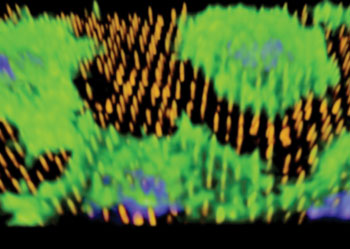New Nano Technique Rapidly Inserts Nucleic Acids into Cells
By LabMedica International staff writers
Posted on 28 Apr 2015
Researchers have unveiled a novel technique for inserting nucleic acids into cells that is based on biodegradable silicon-based "nanoneedles."Posted on 28 Apr 2015
The porous nanoneedles act like a sponge to transport nucleic acids significantly better than similarly sized solid structures. The needles deliver their load by penetrating the cell's outer membrane without harming or killing the cell. The nanoneedles are made from biodegradable silicon that degrades in about two days, leaving behind only a negligible amount of nontoxic orthosilicic acid.

Image: Optical micrograph of human cells (green) impaled on the nanoneedles (orange). The nanoneedles have injected DNA into the cells’ nuclei (blue) (Photo courtesy of Imperial College London).
Investigators at Imperial College London (United Kingdom) and Houston Methodist Research Institute (TX, USA) used nanoneedle technology to deliver DNA and siRNA into human cells growing in culture and into the back muscles of mice. They reported in the March 30, 2015, online edition of the journal Nature Materials that seven days following insertion of the VEGF (vascular endothelial growth factor)-165 gene into the mouse back muscles there was a six-fold increase in the formation of new blood vessels, and blood vessels continued to form over a 14 day period. The technique did not seem to cause inflammation or other apparent harmful side effects.
"This is a quantum leap compared to existing technologies for the delivery of genetic material to cells and tissues," said senior author Dr. Ennio Tasciotti, professor of nanomedicine at Houston Methodist Research. "By gaining direct access to the cytoplasm of the cell we have achieved genetic reprogramming at an incredible high efficiency. This will let us personalize treatments for each patient, giving us endless possibilities in sensing, diagnosis and therapy. And all of this thanks to tiny structures that are up to 1,000 times smaller than a human hair."
Contributing author Dr. Molly Stevens, professor of bioengineering at Imperial College London, said, "It is still very early days in our research, but we are pleased that the nanoneedles have been successful in this trial in mice. There are a number of hurdles to overcome and we have not yet trialled the nanoneedles in humans, but we think they have enormous potential for helping the body to repair itself."
Related Links:
Imperial College London
Houston Methodist Research Institute













